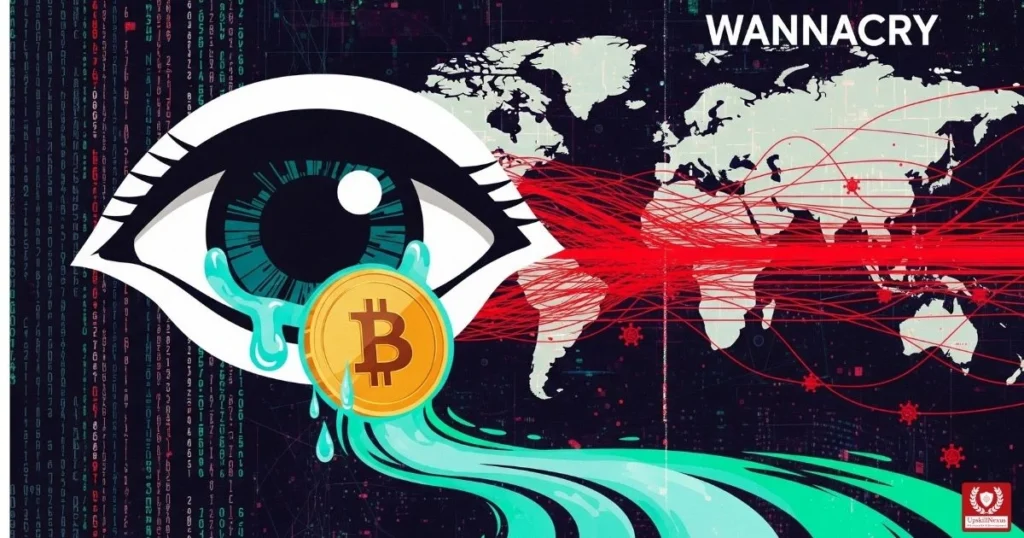You ever open your laptop, click a file, and bam you get hit with a red screen demanding Bitcoin?
If that sounds like a bad dream, well… that’s exactly how hundreds of thousands of people actually started their day back in May 2017. It wasn’t a bug, or a prank. It was ransomware spreading faster than anyone had seen before.
And the name? WannaCry.
Sounds silly, right? But it made the world cry for real. This attack wasn’t just huge. It marked a turning point. It dragged ransomware from underground forums into boardrooms, hospitals, governments everywhere.
Let’s unpack it.
What Exactly Was WannaCry?
WannaCry was a fast-spreading ransomware worm. Once it infected a Windows system, it encrypted files and demanded a ransom in Bitcoin—typically around $300–$600. But here’s the twist: it didn’t spread through phishing emails or shady downloads like most ransomware.
Nope. WannaCry weaponized a leaked NSA exploit. It used a vulnerability in Windows’ Server Message Block (SMB) protocol—specifically, SMBv1. That vulnerability was dubbed EternalBlue, and it came straight out of the U.S. National Security Agency’s cyberwarfare toolkit.
Yeah—this was government-grade malware, turned loose on the public.
How Did It All Start?
It started with a leak.
In early 2017, a mysterious group called the Shadow Brokers dumped a collection of NSA-developed exploits onto the internet. EternalBlue was among them. Microsoft had already issued a patch for it—MS17-010—two months before WannaCry hit.
But guess what?
Millions of systems—especially older Windows 7 and XP machines—never got patched. Or couldn’t be. Or weren’t maintained.
WannaCry exploited that negligence with terrifying efficiency.
Nope. WannaCry weaponized a leaked NSA exploit. It used a vulnerability in Windows’ Server Message Block (SMB) protocol—specifically, SMBv1. That vulnerability was dubbed EternalBlue, and it came straight out of the U.S. National Security Agency’s cyberwarfare toolkit.
Yeah—this was government-grade malware, turned loose on the public.
Worm Mode: No Email Needed
Most ransomware depends on human error—clicking bad links, downloading infected attachments. WannaCry? It needed no help.
Once inside a vulnerable machine, it scanned the network for other systems running SMBv1—and infected them too. Like a virus. Literally. It was self-propagating.
Within hours, it was everywhere. The NHS in the UK had to cancel surgeries. FedEx experienced massive delays. Renault halted production in France. Banks, railways, universities, telecoms—150+ countries.
It was like watching dominoes fall in slow motion.
Who Did It? And What Did They Want?
At first, it felt chaotic. A financial shake-down? A destructive attack? Some weird flex?
Later investigations traced WannaCry back to North Korea’s Lazarus Group, a state-sponsored hacking unit linked to everything from the Sony Pictures hack (2014) to crypto exchange thefts.
So this wasn’t your garden-variety cybercriminal gang looking for lunch money. This was geopolitical—aggressive, deliberate, and arguably reckless.
The motive? Still debated. Disruption? Testing the waters? Fundraising? Maybe all three.
The Kill Switch That Saved Millions
Now here’s the plot twist.
Marcus Hutchins—a 22-year-old security researcher in the UK—was analyzing the code and noticed something strange: WannaCry pinged an odd-looking domain name.
He registered the domain, assuming it was a tracking mechanism.
Turns out? It was a kill switch.
Once that domain was live, infected machines stopped encrypting files. The worm halted—instantly.
A fluke? Maybe. But Hutchins, who later faced unrelated legal troubles, arguably prevented millions more from being infected.
He didn’t just register a domain. He pulled the emergency brake on a runaway train.
What Did We Learn (the Hard Way)?
WannaCry taught a brutal lesson: cybersecurity isn’t just about tools. It’s about timing. And trust.
Patching saves lives. The fix existed. The exploit leaked. But organizations still didn’t act.
Legacy systems are weak links. The NHS was running outdated Windows XP systems. Many others were stuck on unpatched machines for compliance or budget reasons.
Nation-state exploits can boomerang. EternalBlue was never meant to go public. But it did—and the consequences were global.
For professionals, WannaCry became the go-to case study on how fast things can escalate. For students, it’s proof that even textbook vulnerabilities can wreak havoc when ignored.
How WannaCry Changed the Game
Here’s what made WannaCry a turning point:
It changed ransomware from a private crime to a public crisis. Hospitals going dark? That’s not just IT’s problem anymore.
It forced governments to rethink exploit stockpiling. If a backdoor leaks, the damage multiplies.
It led to better emergency patching pipelines. Microsoft even broke protocol to release patches for unsupported systems like XP.
The public saw, maybe for the first time, how a single cyber exploit could ripple through daily life—cancel surgeries, delay trains, halt business.
And that’s sobering.
Final Thoughts: When Malware Went Mainstream
WannaCry didn’t just encrypt files. It encrypted trust.
It forced governments, corporations, and regular folks to reckon with the fragility of the systems we all rely on. It wasn’t some elite “cyberwarfare” scenario. It was people just trying to open a file, and finding their world locked instead.
For cybersecurity professionals, this attack became more than an event. It was a warning shot. A reminder that threats don’t always come cloaked in mystery. Sometimes, they come in bright red popups—with a ticking countdown.
So next time someone asks why patching matters, why legacy systems are dangerous, or why SMBv1 should die a fiery death—just say one word:
WannaCry.

